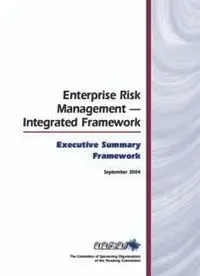Table Of ContentEnterprise Risk
Management —
Integrated Framework
Executive Summary
Framework
September 2004
The Committee of Sponsoring Organizations
of the Treadway Commission
Copyright © 2004 by the Committee of Sponsoring Organizations of the Treadway Commission.
1 2 3 4 5 6 7 8 9 0 MPI 0 9 8 7 6 5 4
Additional copies of Enterprise Risk Management – Integrated Framework: Executive Summary and
Framework and Enterprise Risk Management – Integrated Framework: Application Techniques, 2 vol.
set, item # 990015 may be obtained by calling toll free 1- 888 -777-7077 or visiting www.cpa2biz.com.
All rights reserved. For information about reprint permission and licensing please call (201) 938-
3245. A permissions request form for emailing requests is available at www.aicpa.org/cpyright.htm.
Otherwise, requests should be submitted in writing and mailed to Permissions Editor, AICPA ,
Harborside Financial Center, 201 Plaza Three, Jersey City, NJ 07311-3881.
Committee of Sponsoring Organizations of the Treadway Commission
(COSO)
Oversight Representative
COSO Chair John J. Flaherty
American Accounting Association Larry E. Rittenberg
American Institute of Certified Public Accountants Alan W. Anderson
Financial Executives International John P. Jessup
Nicholas S. Cyprus
Institute of Management Accountants Frank C. Minter
Dennis L. Neider
The Institute of Internal Auditors William G. Bishop, III
David A. Richards
Project Advisory Council to COSO
Guidance
Tony Maki, Chair James W. DeLoach John P. Jessup
Partner Managing Director Vice President and Treasurer
Moss Adams LLP Protiviti Inc. E. I. duPont de Nemours and
Company
Mark S. Beasley Andrew J. Jackson Tony M. Knapp
Professor Senior Vice President of Senior Vice President and
North Carolina State University Enterprise Risk Assurance Controller
Services Motorola, Inc.
American Express Company
Jerry W. DeFoor Steven E. Jameson Douglas F. Prawitt
Vice President and Controller Executive Vice President, Chief Professor
Protective Life Corporation Internal Audit & Risk Officer Brigham Young University
Community Trust Bancorp, Inc.
PricewaterhouseCoopers LLP
Author
Principal Contributors
Richard M. Steinberg Miles E.A. Everson
Former Partner and Corporate Partner and Financial Services
Governance Leader (Presently Finance, Operations, Risk and
Steinberg Governance Compliance Leader
Advisors) New York
Frank J. Martens Lucy E. Nottingham
Senior Manager, Client Manager, Internal Firm
Services Services
Vancouver, Canada Boston
iii
FOREWORD
Over a decade ago, the Committee of Sponsoring Organizations of the Treadway Commission
(COSO) issued Internal Control – Integrated Framework to help businesses and other entities
assess and enhance their internal control systems. That framework has since been
incorporated into policy, rule, and regulation, and used by thousands of enterprises to better
control their activities in moving toward achievement of their established objectives.
Recent years have seen heightened concern and focus on risk management, and it became
increasingly clear that a need exists for a robust framework to effectively identify, assess, and
manage risk. In 2001, COSO initiated a project, and engaged PricewaterhouseCoopers, to
develop a framework that would be readily usable by managements to evaluate and improve
their organizations’ enterprise risk management.
The period of the framework’s development was marked by a series of high-profile business
scandals and failures where investors, company personnel, and other stakeholders suffered
tremendous loss. In the aftermath were calls for enhanced corporate governance and risk
management, with new law, regulation, and listing standards. The need for an enterprise risk
management framework, providing key principles and concepts, a common language, and clear
direction and guidance, became even more compelling. COSO believes this Enterprise Risk
Management – Integrated Framework fills this need, and expects it will become widely accepted
by companies and other organizations and indeed all stakeholders and interested parties.
Among the outgrowths in the United States is the Sarbanes-Oxley Act of 2002, and similar
legislation has been enacted or is being considered in other countries. This law extends the
long-standing requirement for public companies to maintain systems of internal control,
requiring management to certify and the independent auditor to attest to the effectiveness of
those systems. Internal Control – Integrated Framework, which continues to stand the test of
time, serves as the broadly accepted standard for satisfying those reporting requirements.
This Enterprise Risk Management – Integrated Framework expands on internal control,
providing a more robust and extensive focus on the broader subject of enterprise risk
management. While it is not intended to and does not replace the internal control framework,
but rather incorporates the internal control framework within it, companies may decide to
look to this enterprise risk management framework both to satisfy their internal control needs
and to move toward a fuller risk management process.
Among the most critical challenges for managements is determining how much risk the entity
is prepared to and does accept as it strives to create value. This report will better enable them
to meet this challenge.
John J. Flaherty Tony Maki
Chair, COSO Chair, COSO Advisory Council
v
Table of Contents
Executive Summary .................................................................................................................3
Framework ............................................................................................................................11
1. Definition .....................................................................................................................13
2. Internal Environment ...................................................................................................27
3. Objective Setting..........................................................................................................35
4. Event Identification......................................................................................................41
5. Risk Assessment ..........................................................................................................49
6. Risk Response ..............................................................................................................55
7. Control Activities .........................................................................................................61
8. Information and Communication .................................................................................67
9. Monitoring ...................................................................................................................75
10. Roles and Responsibilities ...........................................................................................83
11. Limitations of Enterprise Risk Management ...............................................................93
12. What to Do ...................................................................................................................97
Appendices
A. Objectives and Methodology .......................................................................................99
B. Summary of Key Principles .......................................................................................101
C. Relationship Between Enterprise Risk Management – Integrated Framework and
Internal Control – Integrated Framework .................................................................109
D. Selected Bibliography ................................................................................................113
E. Consideration of Comment Letters ............................................................................115
F. Glossary .....................................................................................................................121
G. Acknowledgments......................................................................................................125
vii
Enterprise Risk
Management —
Integrated Framework
Executive Summary
September 2004

